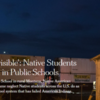Often ignored in the national conversation about the public school achievement gap, these students post some of the worst academic outcomes of any demographic group, which has been exacerbated by decades of discrimination, according to federal reports.
The population is also among the most at risk: Underachievement and limited emotional support at school can contribute to a number of negative outcomes for Native youths — even suicide. Among people 18 to 24, Native Americans have the highest rate of suicide in the nation: 23 per 100,000, compared with 15 per 100,000 among white youths.
Citing these factors, in 2014, the Obama administration declared Native youths and their education to be in a “state of emergency.”
While the Interior Department’s Bureau of Indian Education runs about 180 Native-only schools, more than 90 percent of Native students attend integrated public schools near or on reservations, like Wolf Point. A wealth of rarely tapped data documents their plight.
Nearly a fifth of Native high school students in Montana reported that they attempted suicide at least once in a year — more than double the rate of white students, according to a Montana education agency survey from 2017.
Since passage of the Indian Education Act in 1972, Congress has triedto give tribes more resources and responsibility for educating their children. But most schools that serve Native youths remain under the authority of states and municipalities, which have historically rejected tribal input and insisted on control over curriculum, funding and staffing.
To read more of Erica L. Green and Annie Waldman's article, please click here.



Comments (0)